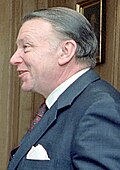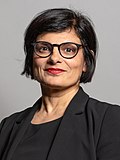Shadow Leader of the House of Commons
British politician role From Wikipedia, the free encyclopedia
The Shadow Leader of the House of Commons is a member of the Official Opposition Shadow Cabinet responsible for working with the Leader of the House in arranging Commons business and holding the Government to account in its overall management of the House. The Shadow Leader also responds to the Business Statement of Leader of House each Thursday, though the Leader of the Opposition exercised this role until the late 1980s. The office is roughly equivalent to the Shadow Leader of the House of Lords.
| Shadow Leader of the House of Commons | |
|---|---|
 | |
| Appointer | Leader of the Opposition |
| Website | The Shadow Cabinet |
Shadow Leaders
- Notes
- Lloyd was Leader of the House before the Conservatives lost the 1964 election and was "retained" in the portfolio of "co-ordination of the Opposition in the Commons.[2] It is not clear whether the Conservative party at this point used the term "Shadow Leader" to describe the job,[3] but the term was used.[4]
- Edward Heath reshuffled the Conservative front bench after being elected leader in the summer of 1964, though he rejected the term "Shadow Cabinet" and instituted a "federal system", three Shadow ministers being in charge of a general area (foreign, economic, and home affairs). For example, Alec Douglas-Home headed foreign affairs, sitting above the Shadow Foreign and Defence Secretaries. The former members of the Shadow Cabinet remained, but three members had no specific responsibilities.[6] It is unclear whether Heath himself was in effect Shadow Leader of the House, as would have been common before the Second World War, or the responsibilities were assigned to one or more shadow ministers.
References
See also
Wikiwand - on
Seamless Wikipedia browsing. On steroids.




























